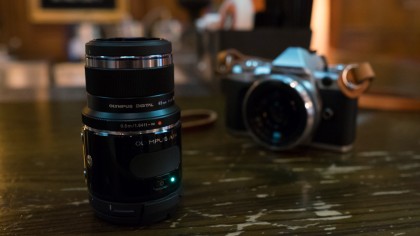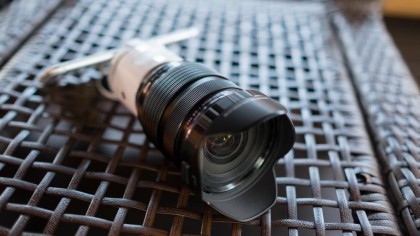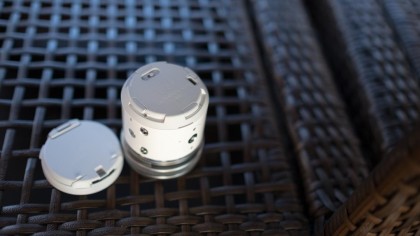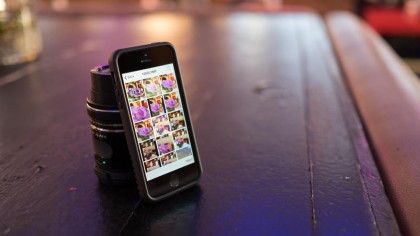TechRadar Verdict
Don't judge the Olympus Air by its small size, this pocket-sized lens camera packs all the image quality and versatility of a traditional Micro Four Thirds camera.
Pros
- +
Stunning image quality
- +
Clever smartphone controls
- +
Affordable MFT camera
Cons
- -
Connectivity issues
- -
No in-body image stabilization
- -
Middling low-light capability
Why you can trust TechRadar
Cameras, as we once knew them, have changed. In just a few years, the popularity of point-and-shoot cameras has given way to smartphones. Similarly, mirrorless cameras are rising in adoption over DSLRs. Soon, the next advent could be Lens Cameras, pioneered by Sony's QX line.
Now, Olympus has introduced its own smartphone-powered entry: the A01 Air.
The Olympus Air might look like an unassuming cylinder no bigger than a can of Red Bull. But really, it's a miniature camera complete with a 16-megapixel (MP), Micro Four Thirds (MFT) sensor and a mount to attach lenses to.
The only thing the shooter lacks is a screen. That's where your smartphone comes in, acting as both a remote control and display for composition.
Priced at $299 (about £195, AU$423) for just the body ($599/£391/AU$849 when kitted with the 14-42mm EZ Lens), Olympus's lens camera is 100 bones cheaper than the $399 (£249, AU$509) Sony QX1, and it has a larger lens family to boot. While the Olympus Air A01 is designed to up your smartphone photography game, it feels more like it's a glimpse of the future for photography. That said, this one is more for diehard enthusiasts than something the average Instagram nut should pick up right now.

Build and handling
The Olympus Air A01 is a tiny thing, measuring only 2.2 inches (56mm) in diameter and 1.7 inches (43mm) tall. It's even lighter than a small jar of baby food at just 0.4 pounds (147g).
The Air certainly earns it name when compared to the heavier the 0.7-pound (216g) Sony QX1. Olympus's lens camera solution is also smaller, thanks to being a perfect cylinder and packing a smaller sensor. The QX1 is a bulkier device, with little offshoots on its puck-shaped body including a pop up flash that bring its overall dimensions up to 2.76 x 2.09 x 2.91 inches (70 x 53 x 74mm).

While this is great for the Air's portability, it doesn't feel like the world's most balanced camera, with half of Olympus's lenses being larger and weighing more than the Air. This is especially apparent when the camera rig tips forward when I have a large lens, like the Olympus 12-40mm f2.8 Pro, attached to the front.
The Olympus Air is similarly light when it comes to onboard controls. Along the top, you'll find a small power button as well as a large oval shaped shutter release, which makes it easy to snap a photo regardless of how you're holding this mini camera.
On the sides, you'll find two switches; one toward the front keeps your lens locked in place, while the one at the rear secures the smartphone clip. You'll use this fold-down clip to attach mobile devices as large as the iPhone 6S Plus and Nexus 6.

Unlike the Sony QX1, the Olympus Air clips your smartphone in place at a diagonal that makes it much more usable for low and high-angle shots. Remove the mobile device mount and you'll find an additional switch to turn off the device's Bluetooth and Wi-Fi in addition to the micro USB charging port.
Unfortunately, you have to peel off yet another plastic cover before you can actually get to the microSD card. While most photographers will be annoyed with all the steps to get to the memory card, not to mention the lack of control dials and programmable shortcut buttons, you'll primarily use the Air through the accompanying OA Central app available on iOS and Android.

Connectivity and the app interface
An iOS or Android phone is essential for using the Olympus Air. Sure, you can go around shooting blindly, but you'll need the companion smartphone to access the full range of shooting modes, tweaks to camera settings and to see what you're actually capturing.
Luckily, Olympus has streamlined the process by integrating NFC into the Air lens camera. Alternatively, you can scan a QR code located on the back to quickly setup a Bluetooth and Wi-Fi connection. Once the devices are paired, you can start up the camera entirely from the app and get to shooting in a few taps.
For the most part, you'll gravitate primarily towards the "Mode Dial" portion of the app, which starts up the camera and lets you get to taking images. From there, the interface is very much like a beefed up iPhone or Android camera app, with a large shutter button at the bottom of the screen.
Along the bottom, you'll also see your basic exposure settings, including shutter speed, ISO sensitivity and aperture. Along the top, you'll also find more settings, including auto focus mode, metering and additional options, like burst mode (which takes a quick succession of images). If you so choose, you can even go into a full manual mode.

On the opposite end of the spectrum, being built for pro photographers, novices can comfortably use this lens camera on automatic modes. Olympus has also implemented an OA Genius function that automatically edits your photos.
The smartphone app essentially takes your original photo and produces six deviations by adjusting exposure and color levels, adding photo filters and cropping the image in creative ways. Users can then choose a version of the image works for them – or just choose the one they originally shot – and the OA Central app will begin to remember your preference.
Whether you're an amateur just getting their feet wet or a veteran photographer who's interested in pushing this camera to its limits, the OA Central is a versatile app that backs up this powerful, pocket camera. But while the app is great, I wish the wireless connection between the Air and smartphone was a bit more reliable – but I'm getting ahead of myself.
Kevin Lee was a former computing reporter at TechRadar. Kevin is now the SEO Updates Editor at IGN based in New York. He handles all of the best of tech buying guides while also dipping his hand in the entertainment and games evergreen content. Kevin has over eight years of experience in the tech and games publications with previous bylines at Polygon, PC World, and more. Outside of work, Kevin is major movie buff of cult and bad films. He also regularly plays flight & space sim and racing games. IRL he's a fan of archery, axe throwing, and board games.

